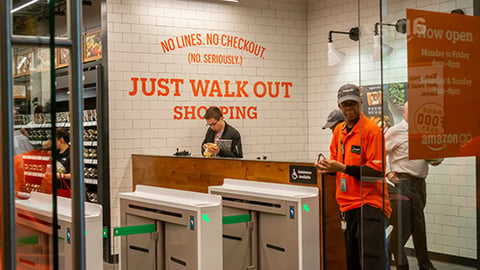3 Tips for Tackling Grocery Store Competition While Improving Customer Experience
Most Americans still prefer buying their groceries in brick-and-mortar stores, despite the rise of online food shopping, according to recent reports. They enjoy picking their own produce, sampling freshly baked goods and grabbing ready-to-heat-and-eat meal kits to take home for dinner. What they don’t like: choke points such as long lines at the checkout.
To give them what they want and to keep them coming back, sweeping changes will continue taking place in the industry, particularly in brick-and-mortar grocery stores. This includes using technology to constantly improve the omnichannel experience and creating ways to provide shoppers with experiences they can’t get online.
As such, there are three overall changes and improvements brick-and-mortar grocers should put in place to go head-to-head with a growing group of competitors in today’s escalating grocery wars:
1. Work toward a frictionless experience
Amazon has set the standard for what frictionless retail should look like, not only with its website but with its “Just Walk Out” shopping experience enabled through its Amazon Go stores.
While this solution is still too cost-prohibitive for others to follow suit, brick-and-mortar grocers are looking at a combination of technologies to remove friction from the last point of the shopping experience. This includes computer vision and digital imagery of bar codes and products to improve the user experience at checkout and, at the same time, reduce errors and shrink. RFID scanning when walking up to a checkout is also a fast and convenient way to capture the contents of a shopping basket. Technologies like these can be paired with artificial intelligence and alternative methods of payment to speed up the checkout process.
However, barriers to creating a more frictionless shopping experience, other than cost, include current store operations and the fact that consumers don’t provide brick-and-mortar stores the same upfront information that they give online retailers to make personalization possible.
2. Deliver greater personalization
Think about it: When shopping online, consumers establish accounts that allow retailers to provide upfront suggestions based on prior shopping habits. However, personalization-driven in-store shopping loyalty programs collect information at the end of the shopping experience, when members scan their loyalty cards.
Until technologies such as geofencing, facial or gait recognition become more accessible for grocers – which could happen in the next three to five years – brick-and-mortar stores will have to rely on other methods of personalization, such as lookalike modeling and making their physical store environments customer-centric rather than product-centric.
Through lookalike modeling, retailers can take demographic and behavioral data points from anyone who completes a sale. After collecting and ingesting that data, the technology uses machine learning and artificial intelligence to analyze that information, identifies patterns most common among people who purchase certain items, and uses these customer characteristics to engage with a larger target audience.
Personalization is also being made possible by changing the way brick-and-mortar stores are laid out and creating areas where customers will want to sit down and stay for a while – thus creating more opportunities for loyalty and sales.
3. Drive differentiation
The savviest brick-and-mortar grocers know that having a physical presence allows them to create in-store experiences that online retailers simply can’t. So they’re creating cafés within the store, offering wine- and beer-tasting opportunities, or holding cooking demonstrations that immerse patrons in a unique grocery shopping experience.
To drive differentiation, many physical grocers are enticing shoppers by carrying more robust, locally sourced fresh fruits and vegetables, a greater selection of heat-and-eat meal kits, and more just-from-the-oven baked goods made on-site.
Finally, the best-ranked stores in the nation have upped their level of customer service by training their associates to be brand ambassadors by going above and beyond. For instance, employees of one national grocery chain physically walk customers to requested products rather than just pointing to an aisle. They also take groceries to customers’ cars instead of having the shoppers do it themselves.
Winning the consumer
Rivalry in the grocery industry is stronger than ever, as physical stores not only have to compete with one another, but with online players as well. The lines between online and physical grocery stores are blurring, and brick-and-mortar retailers are fighting to keep their current customers and trying to lure new shoppers within their store walls.
Technology plays a key role in the grocery store of the future, but so does differentiation through experiences and top-notch customer service. Although constantly changing, technology allows physical stores to work on providing a more friction-free checkout environment that’s similar to online, and enables them to offer greater personalization.
The store of the future is constantly changing. To win in the grocery store wars, physical grocers need to ensure a seamless experience as consumers’ needs, expectations and ways of shopping continue to change, too.







